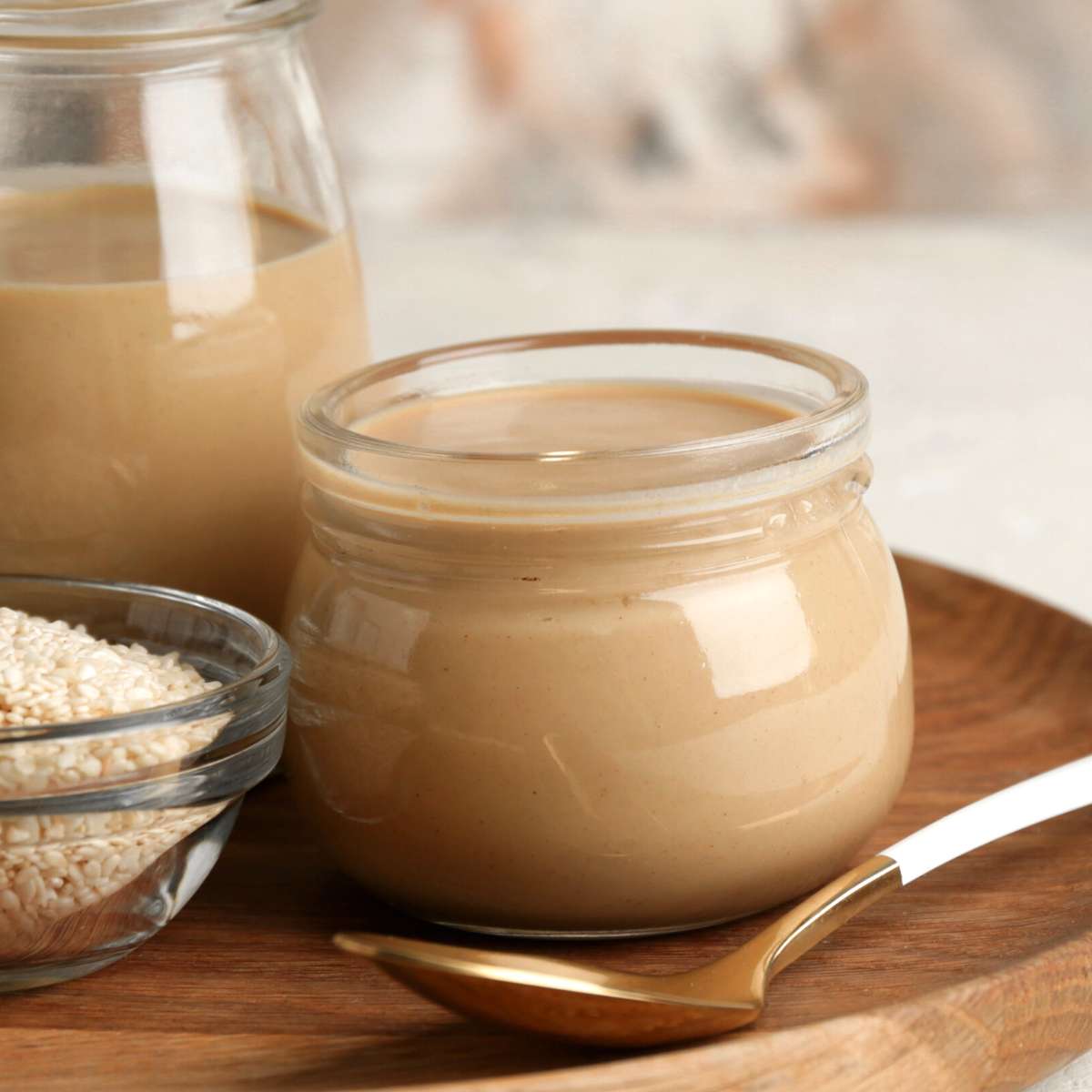Tahini can last a long time if stored properly, but how long does tahini last? Does tahini go bad? Here’s everything you need to know about storing tahini to keep it fresh and what signs to look out for if it’s time to toss it.
This post may contain affiliate links. Read my policy page for more information.

Jump to:
What is tahini?
This beloved condiment in middle eastern cuisine is made from ground sesame seeds. The seeds are hulled to remove that outer bran layer and blended into a creamy paste. Unhulled sesame seeds can also be used but this is more commonly known as organic tahini, or raw tahini, and has a stronger bitter taste.
Tahini is essentially a sesame paste with a similar consistency to peanut butter. It has a slightly bitter, nutty flavor that works well in both sweet and savory dishes.
Tahini is one of the main ingredients in hummus and baba ganoush but you’ll also often see it added to salad dressings or used as a dip on its own.
How long does tahini last?
Tahini can last several years if stored properly. If stored in a cool, dry place like a pantry, it can last for 1-2 years or more. The shelf life of tahini is surprisingly long, due to the antioxidants and natural preservative it contains: sesame seed oil. Sesame seed oil is a bio-preservative that prevents bacterial growth.
An unopened jar of tahini can last even longer than opened. Oxygen, heat and moisture will all cause tahini to go bad over time so opening tahini will speed up the process of oxidation.
It’s important to note that most tahini is not pasteurized in the US. The natural oils are what help make it safe to consume. If there are additional ingredients listed more than just sesame seeds, salt and potentially olive oil, it may not last as long as pure tahini.
Some brands will include extra ingredients so make sure to follow their storage suggestions if the packaging has it.

How long does homemade tahini last?
Homemade tahini doesn’t last as long as store-bought but is still shelf-stable if it’s been stored properly. To increase the longevity of homemade tahini you’ll want to toast your sesame seeds before blending to help destroy pathogens and microbes.
Then store in an airtight container in the refrigerator for 3-4 months for maximum freshness. If you plan to consume right away you can store it at room temperature in a pantry for up to a few days.
Does tahini expire?
Tahini paste can expire, although it is shelf-stable for a significant amount of time. You’ll have the best quality if enjoyed before the best-by date, but it can still be safe to consume if stored properly even after that date. Every store-bought tahini paste will be different depending on the quality of sesame seeds and how it was processed.
Your tahini has expired if it has an unpleasant taste and smell. Additionally, if you see obvious signs of spoilage like a change in color and visible mold growth, it’s time to toss the jar of tahini.
Tips for storing tahini
These are the best storage tips to make sure you can enjoy that jar of tahini until it’s all gone!
- Store in an airtight container, ideally the original container if possible.
- Avoid heat sources like the kitchen cabinet above the stove.
- A cool, dark place like a kitchen pantry is best or the refrigerator. Refrigeration is not needed but does extend the shelf-life of tahini.
- Avoid extreme temperature changes. If you stored it in the refrigerator, keep it there and do not move it back to the pantry for storage. This can cause condensation and the moisture will promote mold and bacterial growth.
- If you don’t think you’ll use up the entire jar before it goes back, pour it into ice cube trays and freeze. Then pop out a serving at a time as need.

Frequently Asked Questions
Signs of spoilage for tahini include a bitter, rancid smell, mold growth, or separation. Separation is not always the case as tahini sitting on the shelf for a prolonged period unused can also cause separation. It will also have a bitter taste.How do you know if tahini has gone bad?
The best place to store tahini is in a cool, dry place. You want to avoid heat and moisture. This typically means a pantry cabinet but can also be the refrigerator. Keep in mind that tahini stored in the refrigerator will thicken, much like nut butters, and not be pourable like it is at room temperature.
Rather than an expiration date, Tahini typically has a “best by” date, which according to the USDA “indicates when a product will be of best flavor or quality. It is not a purchase or safety date.”
If your tahini does not have visible spoilage and is past the best by date, it may still be ok to consume. Rancid tahini will have a bad smell and taste.
Tahini natural separates if it has been sitting for a while. The oil will float on top and paste at the bottom will thicken and harden. This is normal and totally fine to consume!
If this happens, don’t discard that oil on top or you’ll be left with dry, crumbly sesame paste. Instead, shake the jar with its lid tightly closed to help mix it all back together or use a fork to whisk. I’ve even scooped it all into a food processor to mix it up back up. This is the best way to restore it back to it’s creamy consistency without any lumps!
Some tahini will have dark, black specks. This is from the bran (the outer layer of the sesame seed) and is completely harmless.
Tahini Recipes
If you have lots of leftover tahini that needs to be used up before it goes bad, here are some ideas:
Vegan Cookie Fries (use in place of the peanut butter for a nut-free option!)
Brownie Blondies (replace the peanut butter with tahini)






